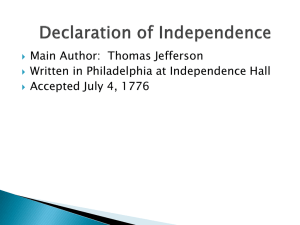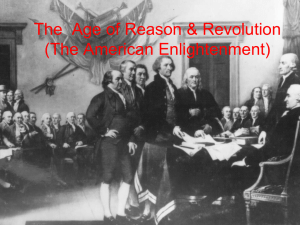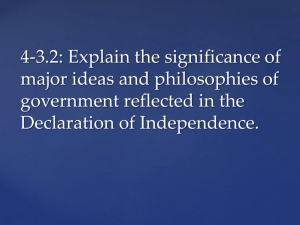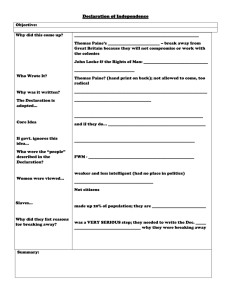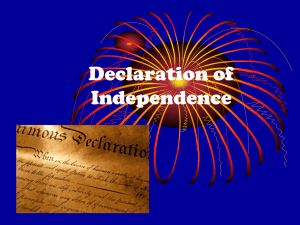Revolution
advertisement
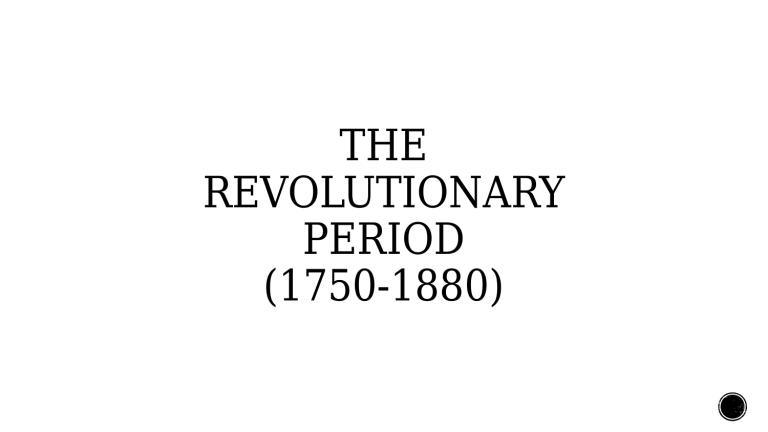
THE REVOLUTIONARY PERIOD (1750-1880) PAINT ME A PICTU RE 2 JOHN ADAMS § “Yesterday the greatest question was decided which ever was debated in America; and a greater perhaps never was, nor will be, decided among men. A resolution was passed without one dissenting colony, that these united colonies are, and of right ought to be, free and independent states” 3 HISTORICAL BACKGROUND ØThe Battle of Saratoga(1977) marked a turning point ØThe war finally came to an end at Yorktown, Virginia on 19th of October 1781. ØCornwallis was forced to surrender. Because of this, the British Parliament decided that the war was no longer worth it and it just had to end. 5 ØOn April 30, 1789, Washington became the first President of the United States ØJohn Adams, a signer of the Declaration of Independence, succeeded him in the office ØThen in 1800, Americans elected Thomas Jefferson. 6 WASHINGTON, ADAMS, AND JEFFERSON 7 Ø(1492) Christopher Columbus discovers America, leads to many European powers founding colonies in that area for the resources Ø(1756-1763) Seven Years War Two Sides: Kingdom of Great Britain and Kingdom of France British Victory, however it leads to massive loss of money for Britain Ø(April 5,1764) Sugar Act America will import sugar and molasses exclusively from Britain with heavy taxes 8 SUGAR ACT AMERICA 9 Ø(November 1,1765) Stamp Act Many materials printed in the colonies had to be on stamped paper, and the stamp had to be paid in British currency; eventually repealed due to boycotting of many british products Ø(1767-1768) Townshend Acts Raised the salaries of governors and judges so that they would remain loyal to Britain; eventually repealed 10 Ø(March 5, 1770) Boston Massacre Occured in Boston, Massachusetts British soldiers were being heckled by a mob, 5 civilians were killed Ø (December 16, 1773) Boston Tea Party Occured in Boston, Massachusetts Carried out by the Sons of Liberty, some disguised as Native Americans, threw nearly 10,000 pounds of tea imported by the British East India Company into the ocean 11 Ø(1774) First Continental Congress Delegates from 12 of the 13 colonies met at Carpenter's Hall in Philadelphia, Pennsylvania Notable names: George Washington, John Adams, and Patrick Henry Ø(January 10, 1776) Common Sense is published Written by Thomas Paine, pamphlet advocating independence from Great Britain Best Selling American Title (proportional to population) Ø (July 4, 1776) Declaration of Independence is ratified Authors: Thomas Jefferson et al. 12 DECLARATION OF INDEPENDENCE 13 LITERARY MOVEMENT LITERATURE IN A TIME OF CRISIS LITERATURE IN A TIME OF CRISIS -public writing was a product of this period -during war of independence, nearly 50 newspapers had been established -during Washington's inauguration, 40 magazines -Almanacs became widely popular across Massachusetts and Georgia -the minds of the people were occupied with politics -journalists and printers provided a forum for an expression of ideas -the main theme used is politics 16 POLITICAL SCENE PATRICK HENRY -the person who gave a speech against the Stamp Act in the Virginia House of Burgesses, which brought cries of TREASON. Ten years later, this speech expressed the rising sentiment for independence. 18 THOMAS PAINE -Another influential person is Thomas Paine who wrote the COMMON SENSE, which created an immediate sensation. -Around 100,000 copies of it were sold in just three months. -Lots of others readers then complemented his ideas. 19 POLITICAL SCENE -The Declaration is considered to be one of the most influential political statements ever made. It was well reasoned and superbly written. -Another document that was very helpful was the Constitution of United States, drafted in 1787. -The contest between supporters and opponents of these constitutions was especially hard fought in New York. 20 CULTURAL SCENE CULTURAL SCENE -Verses appeared in most newspapers, and numerous broadside ballads were published. -One of the most popular broadside ballads was the “The Dying Redcoat”. -”Fight on, America’s noble sons, Fear not Britain's thundering guns; Maintain your cause from year to year, God’s on your side, you need 22 Philip Freneau -Philip Freneau wrote poems throughout his life and his two poems, “The Wild Honeysuckle” and “The Indian Burying Ground” earned his reputation as America’s earliest important lyric poet. 23 Joel barlow wheatley - - and phillis poets Barlow is best remembered for “The Hasty-Pudding”, a mock heroic tribute to cornmeal mush 24 Michel-Guillaume Jean de Crèvecoeur -recorded his impressions on everyday American life and his works were published as “Letters from an American Farmer”. - The best known among others is Benjamin Franklin. 25 CULTURAL SCENE America began to establish a cultural identity of its own. Theaters were built from New York to Charleston. A number of new colleges were built after the war. 26 AMERICAN LITERATURE AT DAYBREAK AMERICAN LITERATURE ATByDAYBREAK early 1800’s, America could boost a small body of national literature. The native Americans had contributed haunting poetry and legends through oral tradition. The Puritans had written a number of powerful and inward looking works . The statesmen of revolutionary period produced political documents for the ages. A few poets and essayists had made a permanent mark on the literature of the young republic. There were, however, no American plays or novels of 28 AUTHORS Benjamin franklin (1706-1790) - made important contributions in a variety of fields, such as literature, science, journalism, education, and philosophy - - - At age 17, he left Boston and went to Philadelphia hoping to open a printing shop of his own He then began to producing a newspaper and an annual publication called Poor Richards Almanac, which contains information, observations, and advice. This work earned him the reputation of being a talented writer. It was done from 1732 until 1757. At age 42, he retired from his printing business 30 Benjamin franklin (1706-1790) - - - - He was just as successful a scientist as he had been a printer. He invented the lightning rod, oxfocals, and a new type of stove. He also confirmed the laws of electricity and contributed to the understanding of ocean currents and earthquakes. Played an important role in drafting the Declaration of Independence , enlisting French support during the revolutionary war, and drafting the United States Constitution. At age 70, he wrote satirical essays, witty “letters", and clever verser 31 Benjamin franklin (1706-1790) Though it was never completed, his autobiography, filled with his opinions and suggestions about self-discipline and morals provides not only a record of his achievements but also an understanding of his character. 32 THOMAS JEFFERSON (17431826) -One of the most widely respected and admired figures in American history. - A gifted writer, diplomat, political leader, inventor, architect, philosopher, and an educator, with an intense belief in equal rights and individual freedoms. 33 THOMAS JEFFERSON (17431826) - - - - Two years after he received his license to law. He was elected to the Virginia House of Burgesses. He became an outspoken defender of American rights. He displayed his persuasive abilities in his pamphlet, “A Summary View of the Rights of British America”(1774) He was then chosen to draft the Declaration of Independence at the Second Continental Congress (1776) 34 Writer’s techniques Aphorisms -brief statements expressing wise observations or general truths -sometimes have rhymes and repeating words -is used by Benjamin Franklin in Poor Richard's Almanack -Examples: "Fish and visitor smell in three days." "If your head is wax, don't walk in the sun." "Early 36 Parallelism -sentences with parts that are grammatically the same -adds a sense of rhythm and order to the sentence. -is used by Thomas Jefferson in the Declaration of Independence. -Example: In the Declaration of 37 Loaded Language -also known as "charged words” -wording that attempts to influence an audience by using appeal to emotion 38 Satire -using humor, irony, exaggeration, or ridicule to criticize people or ideas in a humorous way -is commonly used in making a political statement -example: Benjamin Franklin's "A Witch Trial ay Mount Holly" 39 Other writing techniques used during the revolutionary period were PERSONIFICATION, STRONG IMAGERY, and ALLUSIONS. Those writing techniques were used by Thomas Paine in "The American Crisis”. 40 THE DECLARATION OF INDEPENDENCE 42
